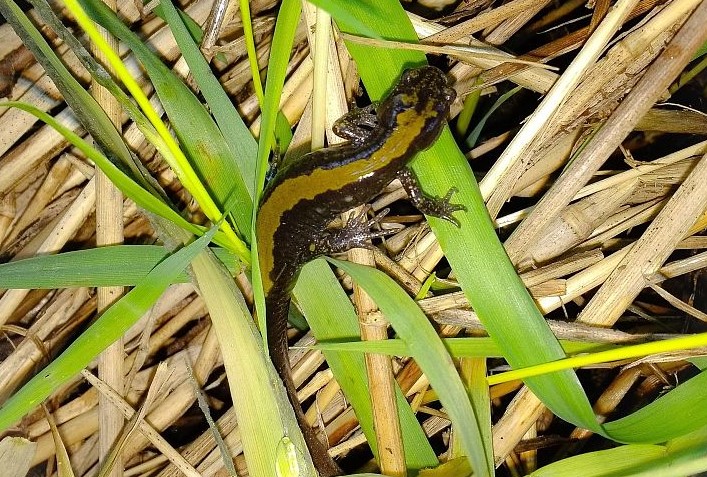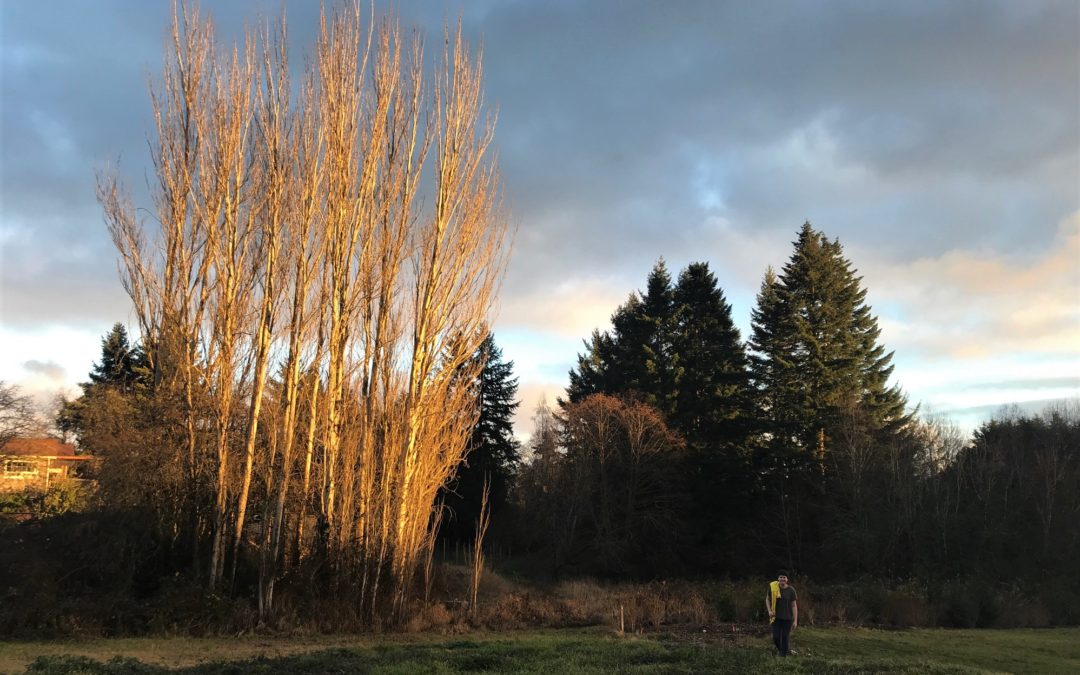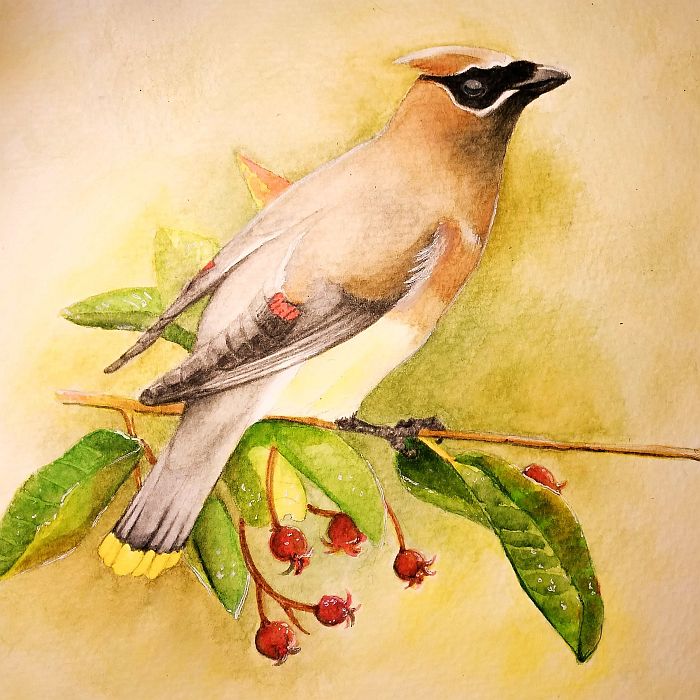Photos, paintings, and writing by: Paulina Barry
My name is Paulina Barry, and I am the Heron Wetland Education and Stewardship Intern. Heron Meadow is a two-acre wetland, owned by Vashon Center for the Arts, and home to Vashon Nature Center’s field office. In 2019, Vashon Center for the Arts and Vashon Nature Center created a partnership to restore this wetland meadow to become a sanctuary for native wildlife and a demonstration site for how to enhance wildlife habitat.

In the time of Covid-19, I am grateful to be able to continue to steward Heron Meadow and only wish I could bring our community together to help in this restoration as we had hoped and planned. Over the past few weeks we have shifted our focus from volunteer work parties and communal events, to developing a science based monitoring program for the flora and fauna on site. I have been working with Vashon Nature Center Director, Bianca Perla to develop monitoring protocols to track and learn about insects, plant cover, birds, and amphibians present at Heron Meadow. In addition, we have installed a wildlife camera that I check every week for mammals that visit. The data collected now and over the years will show how the Heron Meadow restoration site changes in its ability to provide quality habitat for native flora and fauna.

With Spring bringing us rain, sunshine, and warmer weather, the plants have burst from dormancy and are growing well. Our willows, red-flowering currants, and osoberry have been some of the first to flower, providing early nectar sources for insects and birds. The newest editions to Heron Meadow are three Garry Oak (Quercus garryana) saplings generously donated by John Browne. They are small now, but in time volunteer work parties will be picnicking under their shade.
Originating in Eurasia, Reed canary grass (Phalaris arundinacea) has become invasive in Washington State wetlands. Their extensive and vigorous root systems prevent native Pacific Northwest wetland species from flourishing. This causes vulnerable areas to become mono-crops, which reduces the quality of habitat for wildlife. Our defense against the spread of reed canary grass is cardboard, stripped of all plastic tape and labels. Little to no sunlight passes through cardboard, preventing the grass and other invasive species from growing tall and flowering. This gives native plants a chance to establish and shade out the grass eventually allowing for regeneration of native vegetation. During my work at the meadow, I have noticed invertebrates, amphibians, snakes, and small mammals all find shelter under the cardboard. Over time the weeds wilt and the cardboard decays, locking in moisture and serving as habitat for other invertebrates and amphibians like our native tree frogs and salamanders. As the monitoring and restoration continues, we hope to see increased biodiversity and decreased non-native species. Already the prospects are looking good, but it takes time and effort to continue progress.
Getting outside and working on the monitoring and restoration on the site is inspiring in many ways. It allows me to know the birds on a more personal level. The same individual birds each week are counted in my surveys and I notice when other birds are just visiting, or planning to stay for a while. I’ve come to better appreciate the beauty of our native animals and plants, incorporating them as subjects in my own artistic project, through watercolors and photography. Artistic and scientific expression come together so naturally on Vashon. In the future, Heron Meadow will be a place for everyone to explore art and science in harmony.
If you are interested in learning more about how to enhance your backyard habitat, and how we are doing it at Heron Meadow, please leave a comment!
Header photo: Heron Meadow at sunset. photo by: Bianca Perla




Wonderful to read this . I am one of your three adjacent neighbors, the midle one. We just have touching borders for about twenty feet. i have walked down and explored the property and am delighted to read about your work.
I am restoring my property to get rid of invasives and plant natives only around our pond and in my two acre forest. You may have heard my sheep. They mow my meadow.
Sheila, wonderful to meet you and have you as a neighbor to this place. We do enjoy hearing your sheep when we are working there! Wonderful that you are restoring your property too. Feel free to walk over and meet us or give a wave sometime! Good luck with your work. With each of us working on each property it will make more of a difference! So great to hear. Bianca
Thank you Sheila. I enjoy hearing your sheep while I’m out in the meadow. It’s great to know you are working to restore your property. The bird life around the area is really supported by the bordering trees and shrubs, including yours. Feel free to check out what we are doing at the meadow and say hi!
Paulina
The meadow is beautiful! Your art is amazing. I would love to know more about native plants and inviting wildlife into my garden. Thank you for all your hard work
Thank you Geralyn! For learning about gardening with native plants, I suggest perusing the Washington Native Plant Society’s website www.wnps.org.
You are doing a great job, paulina! Wish to be out there lending you a hand. Love your art work and your dedication to restoring this BEAUTIFUL site.
Thank you Karen. I wish we could work together as well. The Meadow is only getting more beautiful everyday.
Paulina
It is wonderful to see this formerly neglected wetland meadow get some TLC- I’ve been picking tansy ragwort out if it for years. Lovely to hear about all the critters sheltering under the cardboard sheet mulch! Excellent work Paulina and everyone at VNC.
Thank you Maria for making the efforts to keep invasive species down before this project began. I grew up walking by all the time wondering about what this meadow could become and I am so happy to be a part of its restoration now with VNC and VCA.
Paulina
Great article. I had no idea cardboard could be recycled into something so cool!
Thank you! It’s great to use it and see how it works over time. I really wonder what the area will look like next year.
Focusing on a meadow is ablolutely the healthist activity to be ingaged in now. Restorive for soul, mind, and meadow. If we can keep the birds, salamanders and other crawley critters happy then we have a chance to redeem our own species. Keep up the fantastic work Paulina.
Paulina is doing a fantastic job!
I completely agree, thank you. The little spiders are all carrying eggs and the snakes and frogs are out and about. This is their space and I am so happy to be part of keeping it healthy.
Love this work- thank you for the updates- and hope to join you Giving back to the meadow And basking in it’s Beauty one day.
We look forward to the days when we can all be there in groups, weather to learn, restore, or just relax. The Meadow is always open for a walk through on your own if you are curious to see what’s being done.